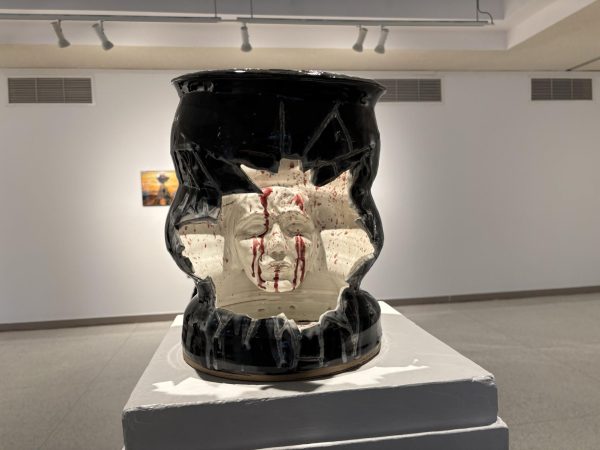Netflix’s ‘A.M.I.’: classic horror tactics, modern twist
Recent film sure to please viewers, leaves notes of ambiguity behind it
Netflix, the streaming service turned media empire, is widely known for its original series and movies, especially during the holiday season. From “A Christmas Prince,” the holiday-themed romantic comedy that caught news headlines, to “Roma,” which netted Netflix a 2019 Oscar nomination, the holidays have always been Netflix’s time to drop its new standout titles.
This year’s Halloween season will be accompanied by a number of new Netflix original horror and thriller movies, and these films pay homage to, and modernize, the classic approaches to horror that defined the genre. One of these new films, “A.M.I,” ties together aspects of fear and terror that quickly remind the viewer of the danger in their own pocket.
Directed by Rusty Nixon, the film stars Cassie, played by Canadian actress Debs Howard, and is set in the aftermath of her mother’s passing. Her sadness and perceived loss is noticed by an artificial intelligence program called “A.M.I” that is integrated into her phone with the latest update. The relationship between Cassie and A.M.I. quickly grows as she gives it the moniker of “mother” and has it refer to her as “daughter.” From there, things escalate as A.M.I. encourages Cassie to do increasingly dangerous and troubling things at an alarming rate.
The film opens on a scene of a seemingly rushed woman as she enters the woods on a trail at night, and later hears and sees an odd light and noises, which is a classic horror trope that has been used time and again. The suspenseful image of the lone woman at night in the woods has been around and seen before in major films like “The Blair Witch Project,” but A.M.I. uses this image as a transition into a jump scare, and ultimately a fair bit of foreshadowing in the following shot.
As the protagonist is introduced and begins her relationship with the A.M.I. interface she previously mocked her friend for using, the film seems to be more suspenseful than terrifying. This quickly changes as the killings begin when Cassie, at the advice of her phone, finds her boyfriend, Liam (played by Sam Muik), cheating on her with her friend Sarah (played by Veronica Hampson). Her quick response includes intentionally breaking her cheating boyfriend’s leg and arm after she sees him flirting with another student, and it highlights the other aspect of this film that is nuanced from the beginning.
Ultimately, the final transition that Cassie undergoes, from the portrayed innocent and trusting student to the cold and confused killer who lacks remorse, comes as she loses the last person who wants to help her. When she pours what appears to be a highly caustic type of acid on her father after he discovers her murderous actions, she kills the only person who continues to want to help her, and this is echoed in her father’s final words of “I love you. You can’t go back from this. Please don’t.”
Cassie is seen from the first shot at her mother’s grave, through the first time she takes A.M.I. there, using pills that are meant to treat head injuries, but cause mood disorders, such as bipolarity.
Given her use of medication upon bringing A.M.I. into her life, and the lack of that medication afterwards, the film suggests that while some of her actions may be influenced by the artificial intelligence, it is also entirely possible it is her own injured mind justifying her actions and anger.
Throughout the film, A.M.I. takes on a red glowing circle when suggesting Cassie commit acts of violence, which seems to be a tribute to the movie “2001: A Space Odyssey,” where a similar looking AI named Hal 9000 wreaks havoc. Frequently, the voice of A.M.I. instructs Cassie on what to do to exact revenge, as well as offers advice through the form of storytelling. This storytelling mirrors the first scenes between Cassie and A.M.I., where she is imitating reading Cassie to sleep like her deceased mother used to. The parallel between telling a children’s story and aiding the process of murder and body disposal adds an additional level of creeping suspense and classic horror to this film.
Ultimately, the movie’s climax pits Cassie against Liam in a fight between both them and their A.M.I.s, which highlights the crucial impact that these AI devices have on the users. During this fight, Cassie’s smashes Liam’s door while it is locked in what appeared to be another tribute, this time to horror classic “The Shining,” which features star Jack Nicholson tearing a door down with an axe in identical fashion. The movie’s conclusion, which sees Cassie surrounded by multiple phones that each represent a different member of her family, including a phone in a bassinet to represent her child, suggests once again that Cassie’s brain injury may be to blame for all of her behavior after all.
Overall, the film included new takes on classic horror stories, and modernized them with technology. The tributes paid to the horror legends that influenced this movie are apparent, and suggest a deep connection to the root of “scary” itself. If you’re looking for a fresh new Halloween movie to make you question your own iphone, “A.M.I.” is on Netflix now.







